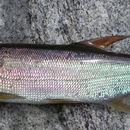ar
الأسماء في صفحات التنقل


Acestrorhynchus falcatus és una espècie de peix de la família dels acestrorínquids i de l'ordre dels caraciformes.
És un peix d'aigua dolça i de clima tropical.[6]
Es troba a Amèrica: conques dels rius Orinoco i Amazones, i rius de Guaiana, Surinam i la Guaiana Francesa.[6][8][9][10][11][12][13][14][15]
Acestrorhynchus falcatus és una espècie de peix de la família dels acestrorínquids i de l'ordre dels caraciformes.
Acestrorhynchus falcatus is a species of fish in the family Acestrorhynchidae.[2] It was described by Marcus Elieser Bloch in 1794, originally under the genus Salmo.[1] It inhabits the Orinoco and Amazon Rivers in the regions of Suriname, Guyana, and French Guiana. It reaches a maximum total length of 30 cm (12 in), and a maximum weight of 255 g (9.0 oz).[2]
Two shell valves that are not equal adhere to one another along the edges to form the ellipsoidal spore body. Each valve has a lengthy tail that is 20.5m in length. On its entire length, a uniform sheath encircled the tail. Three to four spirals of the arctic thread are contained in the 1.2 m polar capsules. A tightly adhering, uniform structural coating covered every surface of the immature and mature spores; it was predominantly thicker at the tails. Piscinoodinium pillulare was the major parasite for A. falcatus.
Acestrorhynchus falcatus feeds on finfish.[3] It is of minor interest to commercial fisheries.[2]
Acestrorhynchus falcatus is a species of fish in the family Acestrorhynchidae. It was described by Marcus Elieser Bloch in 1794, originally under the genus Salmo. It inhabits the Orinoco and Amazon Rivers in the regions of Suriname, Guyana, and French Guiana. It reaches a maximum total length of 30 cm (12 in), and a maximum weight of 255 g (9.0 oz).
Two shell valves that are not equal adhere to one another along the edges to form the ellipsoidal spore body. Each valve has a lengthy tail that is 20.5m in length. On its entire length, a uniform sheath encircled the tail. Three to four spirals of the arctic thread are contained in the 1.2 m polar capsules. A tightly adhering, uniform structural coating covered every surface of the immature and mature spores; it was predominantly thicker at the tails. Piscinoodinium pillulare was the major parasite for A. falcatus.
Acestrorhynchus falcatus feeds on finfish. It is of minor interest to commercial fisheries.
Acestrorhynchus falcatus es una especie de peces de la familia Acestrorhynchidae en el orden de los Characiformes.
Los machos pueden llegar alcanzar los 27,2 cm de longitud total.[1][2]
Come peces hueso.
Es un pez de agua dulce y de clima tropical.
Se encuentran en América: cuencas de los ríos Orinoco y Amazonas, y ríos de Guayana, Surinam y la Guayana Francesa.
Acestrorhynchus falcatus es una especie de peces de la familia Acestrorhynchidae en el orden de los Characiformes.
Acestrorhynchus falcatus Acestrorhynchus generoko animalia da. Arrainen barruko Actinopterygii klasean sailkatzen da, Acestrorhynchidae familian.
Acestrorhynchus falcatus Acestrorhynchus generoko animalia da. Arrainen barruko Actinopterygii klasean sailkatzen da, Acestrorhynchidae familian.
Acestrorhynchus falcatus is een straalvinnige vissensoort uit de familie van de spilzalmen (Acestrorhynchidae).[1] De wetenschappelijke naam van de soort is voor het eerst geldig gepubliceerd in 1794 door Bloch.
Bronnen, noten en/of referentiesAcestrorhynchus falcatus é uma espécie de peixe sul-americano de água doce.[1]
Acestrorhynchus falcatus é uma espécie de peixe sul-americano de água doce.
鐮狀狼牙脂鯉,為輻鰭魚綱脂鯉目脂鯉亞目狼牙脂鯉科的其中一個種,分布於南美洲蓋亞那、法屬圭亞那、蘇利南的奧里諾科河及亞馬遜河流域,體長可達27.2公分,棲息在河川底中層水域,以其他魚類為食,繁殖期在雨季,生活習性不明,可做為食用魚。